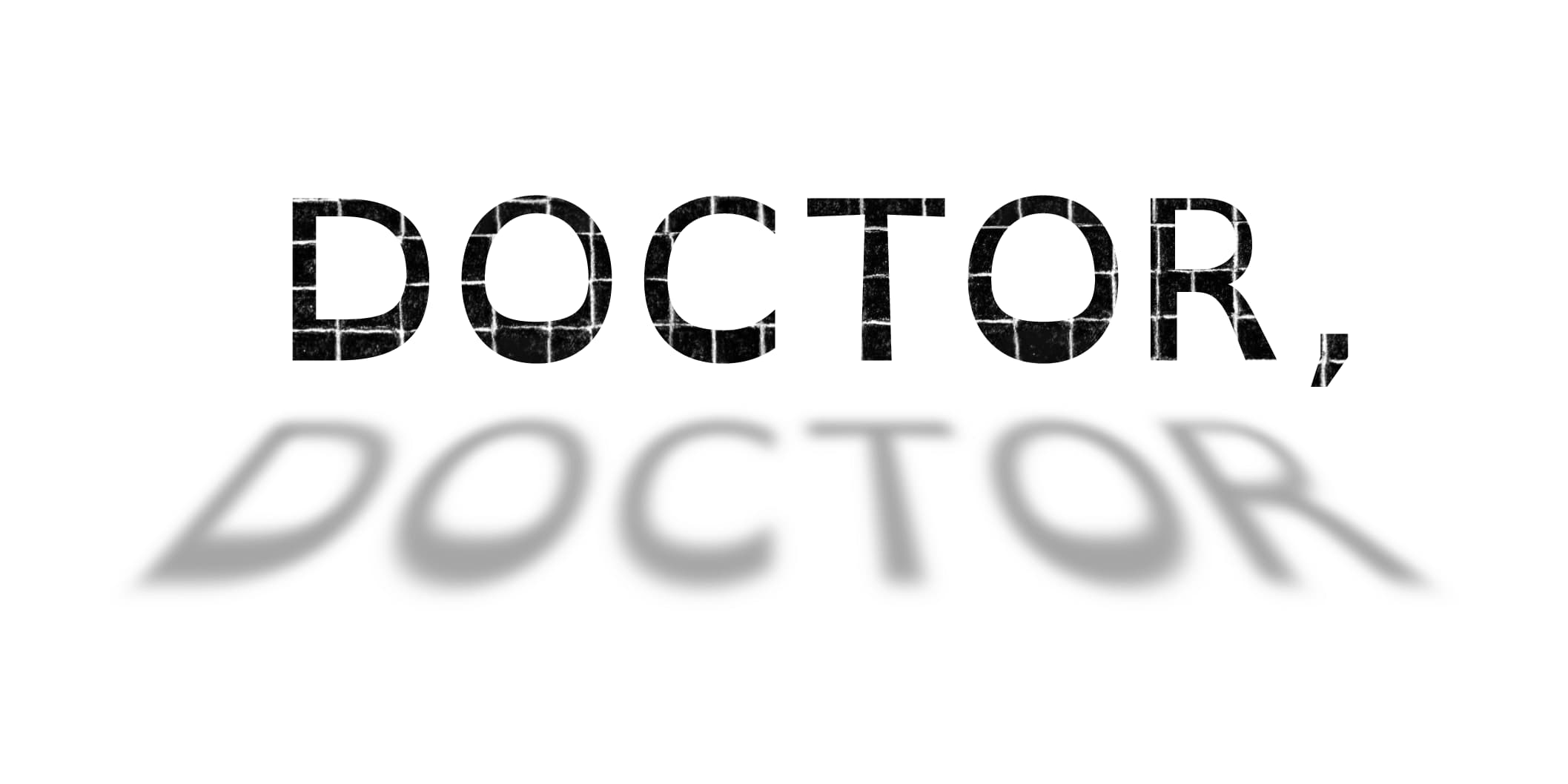
First, a hospital check-up: In a cramped room, a doctor stands behind a curtain and shines a large, round headlamp at a patient’s face, casting their shadow in profile on a tiled wall. The doctor records notes on his clipboard. The patient’s robe slips off their shoulder as they look warily back toward the doctor.
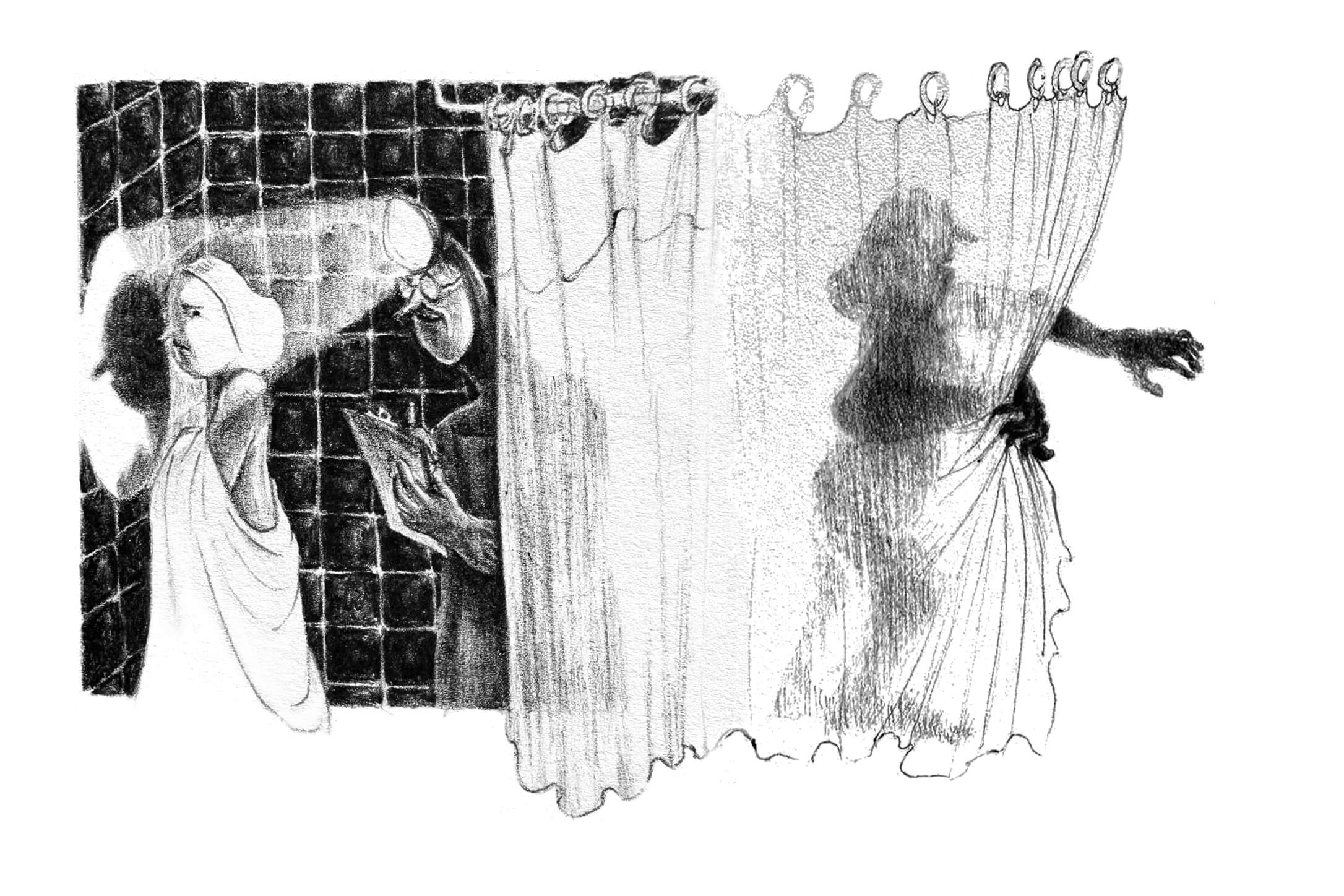
11. The past does not contain itself—it sprouts through cracks in dried mud and fissures in stone.
Earlier this year, Canada’s permissive euthanasia laws came under scrutiny. Medical professionals were found to be routinely encouraging people with non-terminal disabilities to consider assisted suicide in order to avoid the high costs associated with accessible housing and enabling devices.
There is still the temptation to weed out slow movers as civilization hurtles furiously forward in the name of progress… to escort us from sleek, gridded rooms and lose us in a tangle of roots and reeds and winding caverns. To casually discourage our birth, burying the very idea back in the earth.
But there is something else lying dormant there too,
deep in the soil.
The same hospital room, spun ninety degrees to an even more claustrophobic angle and seen from the eyes of the patient. Three gridded, tiled walls close in around the doctor watching through a small dark window.
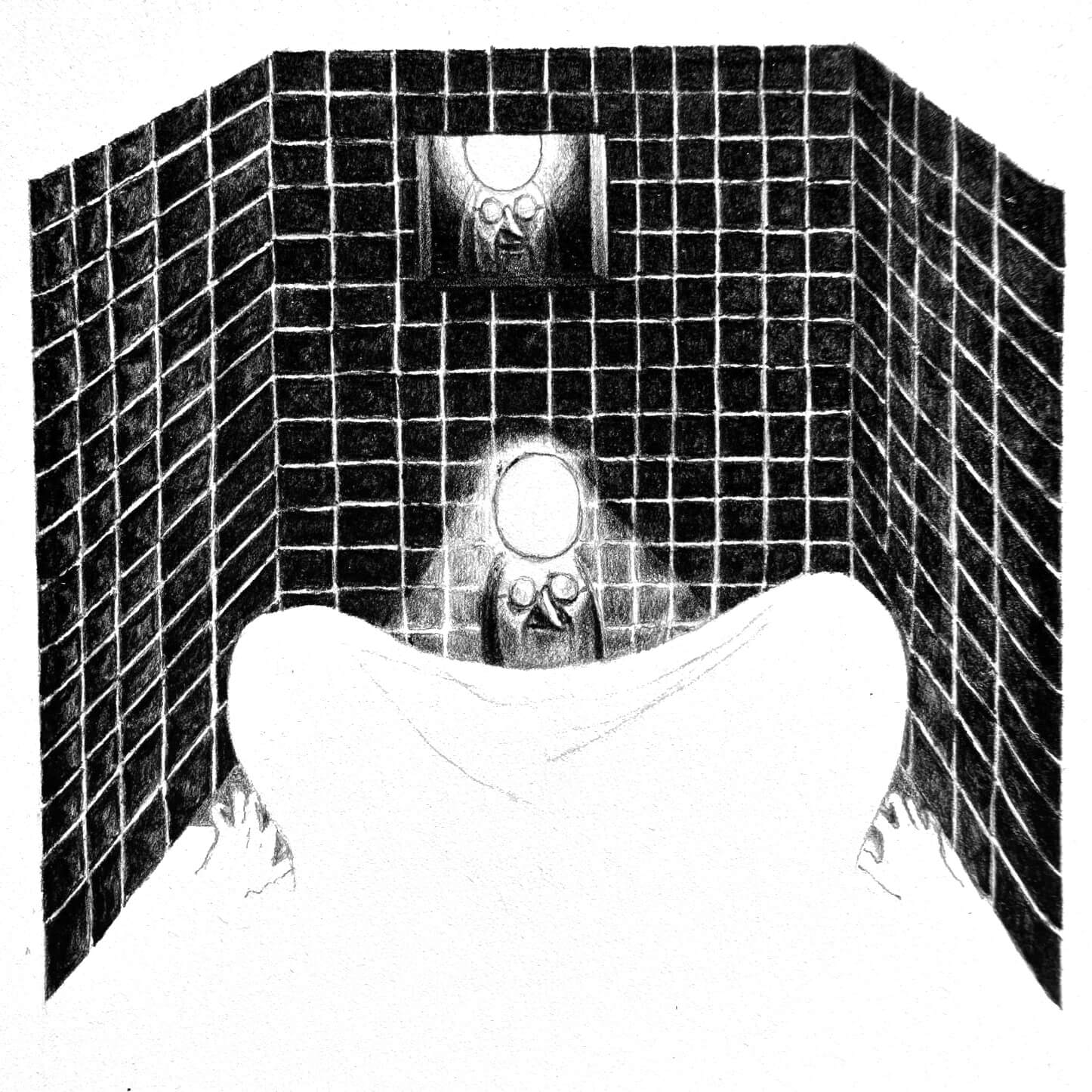
10. “Make sure you don’t have a son because the x-linked recessive inheritance pattern of muscular dystrophy indicates a boy will also suffer from the disease.” The appointment wasn’t about family planning, and my doctor was a young woman fresh out of her residency. But here it was again, laid bare and shivering beside me on the exam table: the cold confirmation that “another child like you should not be here.”
We’re viewing the room from farther away, between tall curtains that spread to reveal dark tiled walls and the doctor sitting on a three-legged stool.
On the right is the same small window and identical grinning doctor, his glasses reflecting the room’s clinical light.
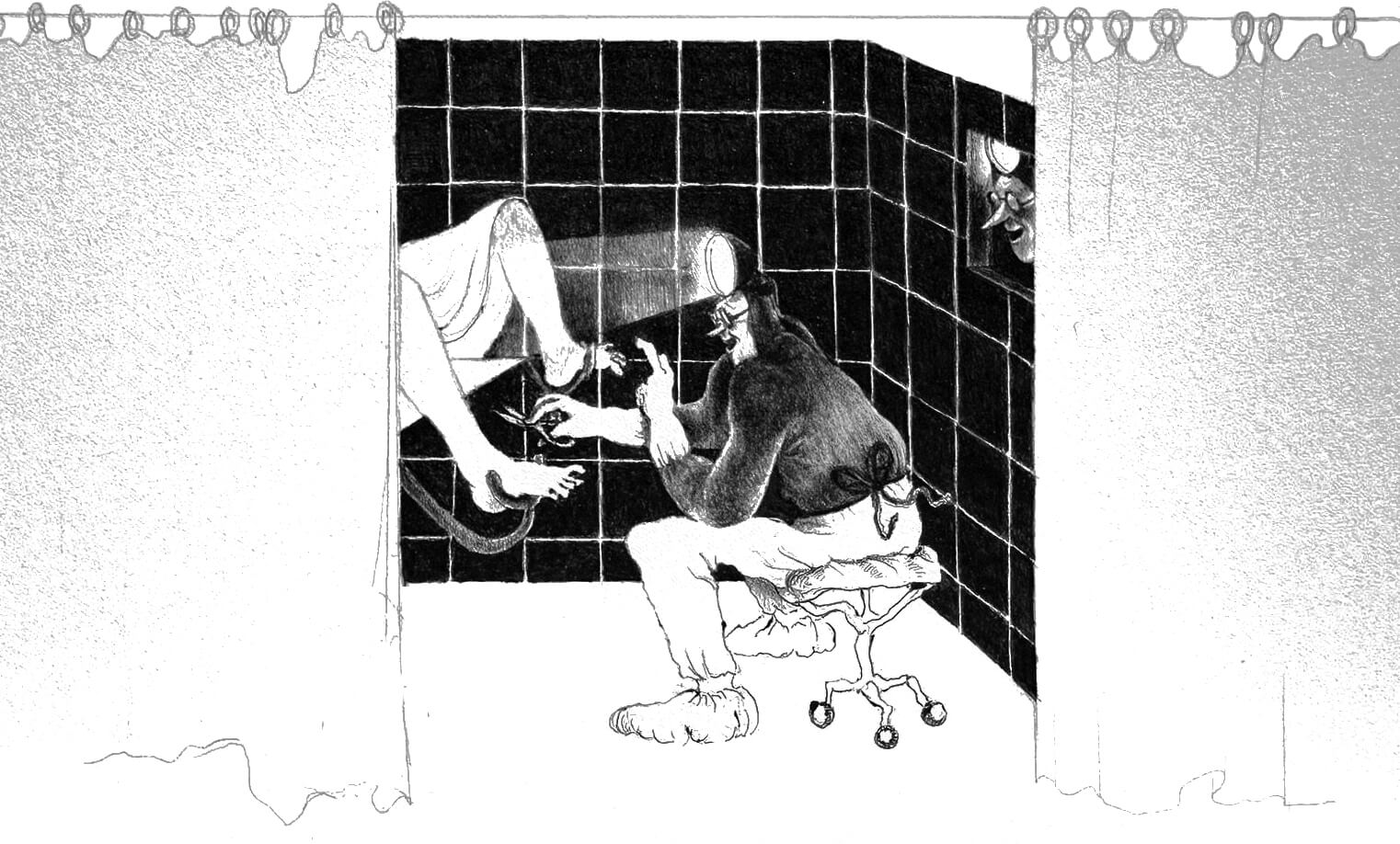
9. I moved to California in 2017. During a routine check-up with my new general practitioner I was told, “make sure you don’t have a son…”
We leave the exam room and move down the corridor. More matching doctors queue up eagerly with headlamps buzzing. Each wears glasses, gloves, and a thick rubber apron. They cluster in the foreground of a lecture hall.
One doctor stands at a podium, clutching a clipboard and raising his hand in an eerie salute.
Behind him, his dark shadow looms huge and warped and frightening.
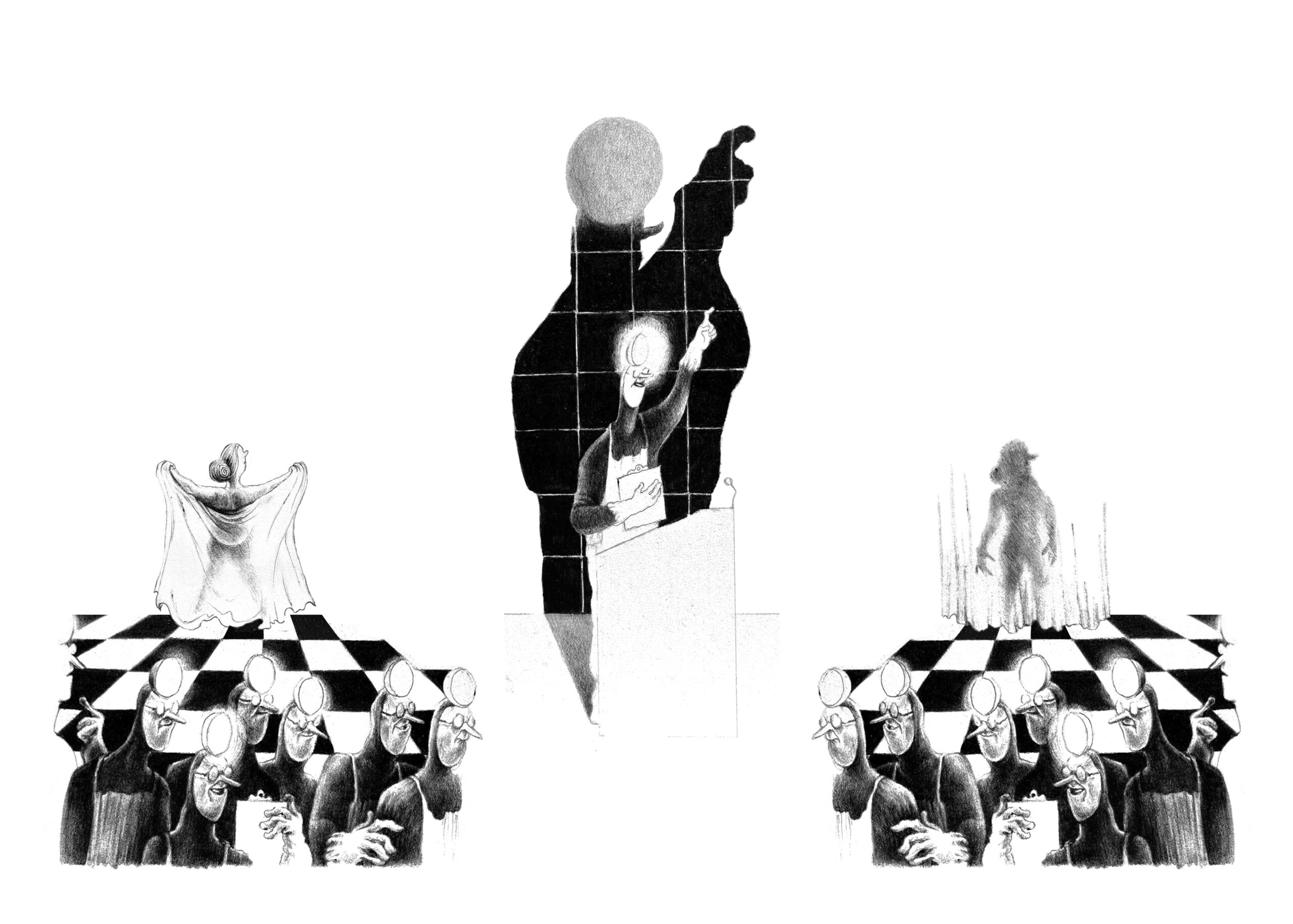
8. Fascist leaders embraced extreme genetic determinism as they sought to eliminate all people perceived to be physically, mentally, or morally weak, and therefore enemies of a strong nation state.
In accordance with the racist doctrine of eugenics, anyone deemed “unfit” to reproduce— among them the poor, the incarcerated, the sexually liberated, the disabled, and in particular those from Black and Indigenous communities—could be forcibly sterilized or castrated.
In the United States, tens of thousands of disabled people underwent these procedures against their will and often without their knowledge. At the turn of the twentieth century, more than half of the operations were carried out in California.
Somewhere toward the back of the lecture hall, there’s a latecomer, a straggler. This lone doctor holds a blank expression. His own shadow stretches onto the tiled wall behind him and overlaps with the bottom of a large poster.
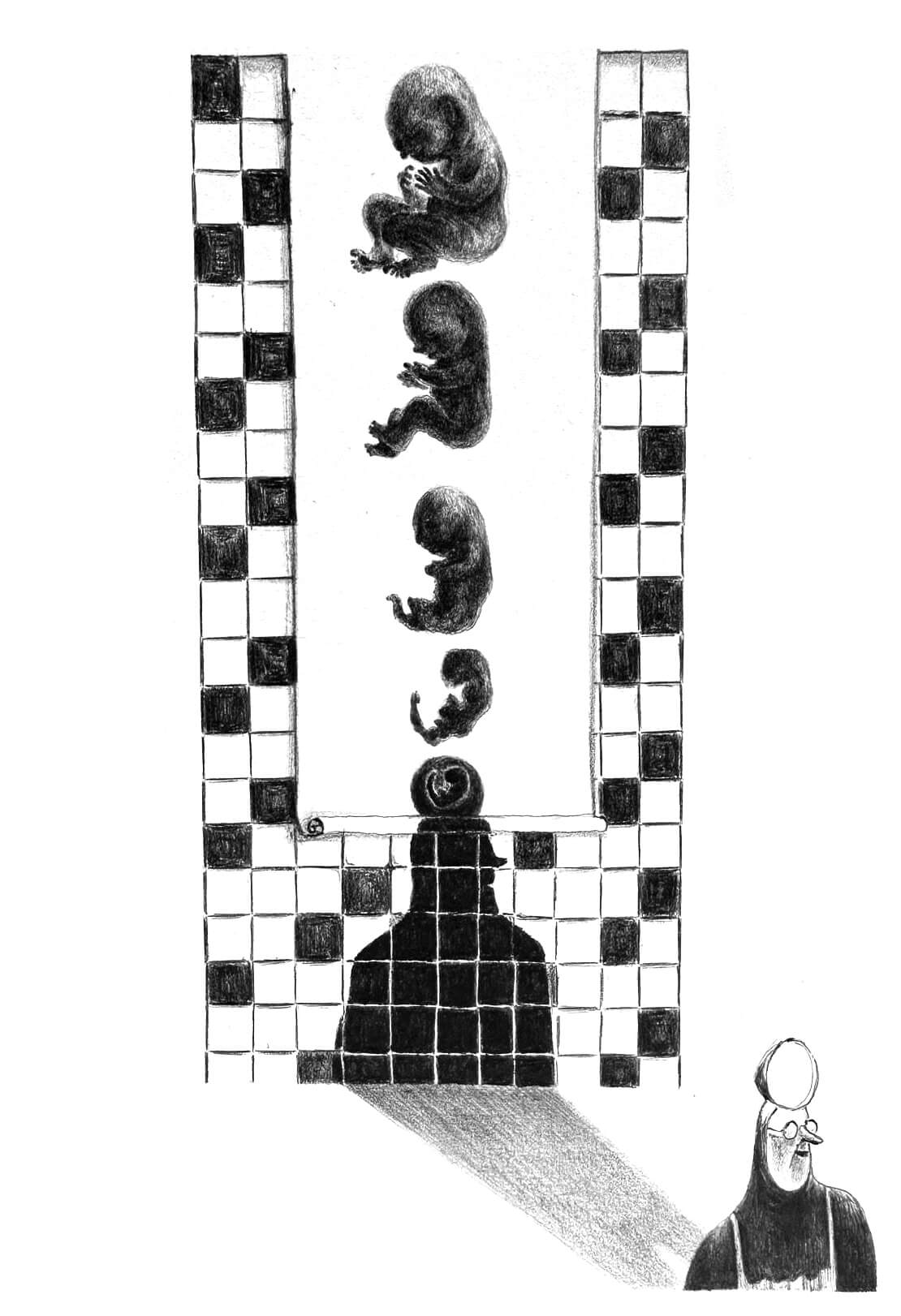
7. The seed of that twisted idea germinated: Why not grow toward unblemished homogeneity? Breed out the cursed changeling children, the very shadow of your doubt.
The scene changes—the poster and doctor are gone. In their place stands a formidable wall and a gridded stone threshold. Through the doorway, nothing at all.
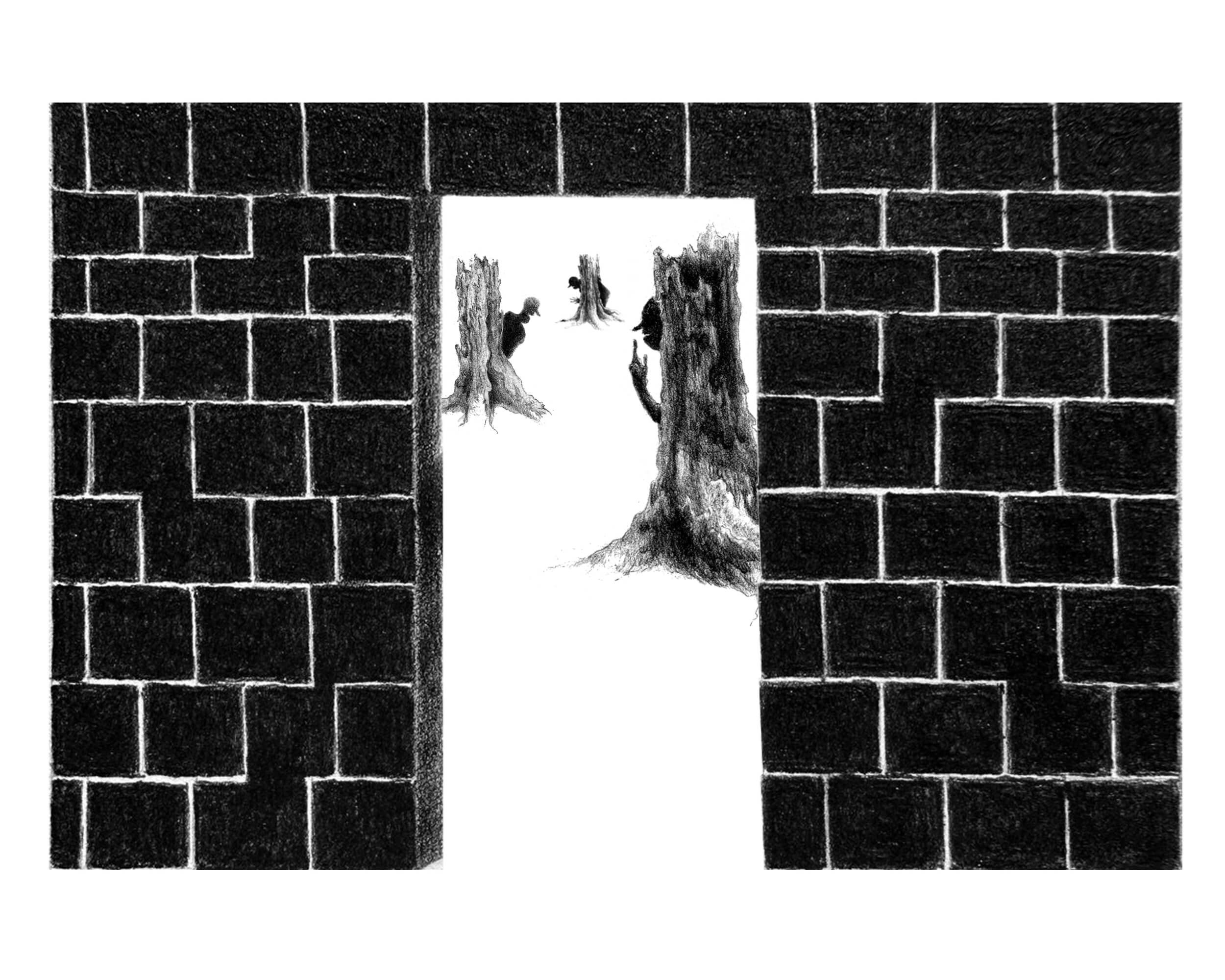
6. A passage from Leviticus reads, “Whosoever…hath any blemish, let him not approach to offer the bread of his God. For whatsoever man he be that hath a blemish, he shall not approach: a blind man, or a lame…Or a man that is brokenfooted, or brokenhanded, or crookbackt, or a dwarf… Only he shall not go in unto the vail, nor come nigh unto the altar, because he hath a blemish; that he profane not my sanctuaries.”
And so a boundary was drawn around the altar, parsing a single body from the community, or even dividing it from its own ailing limbs. Cut the branches from a blighted trunk; pluck the soul from frail, unworthy flesh.
We’ve transported inside the hushed home. There’s a sleeping baby snug under blankets in a woven wicker basket, rocking on the floor.
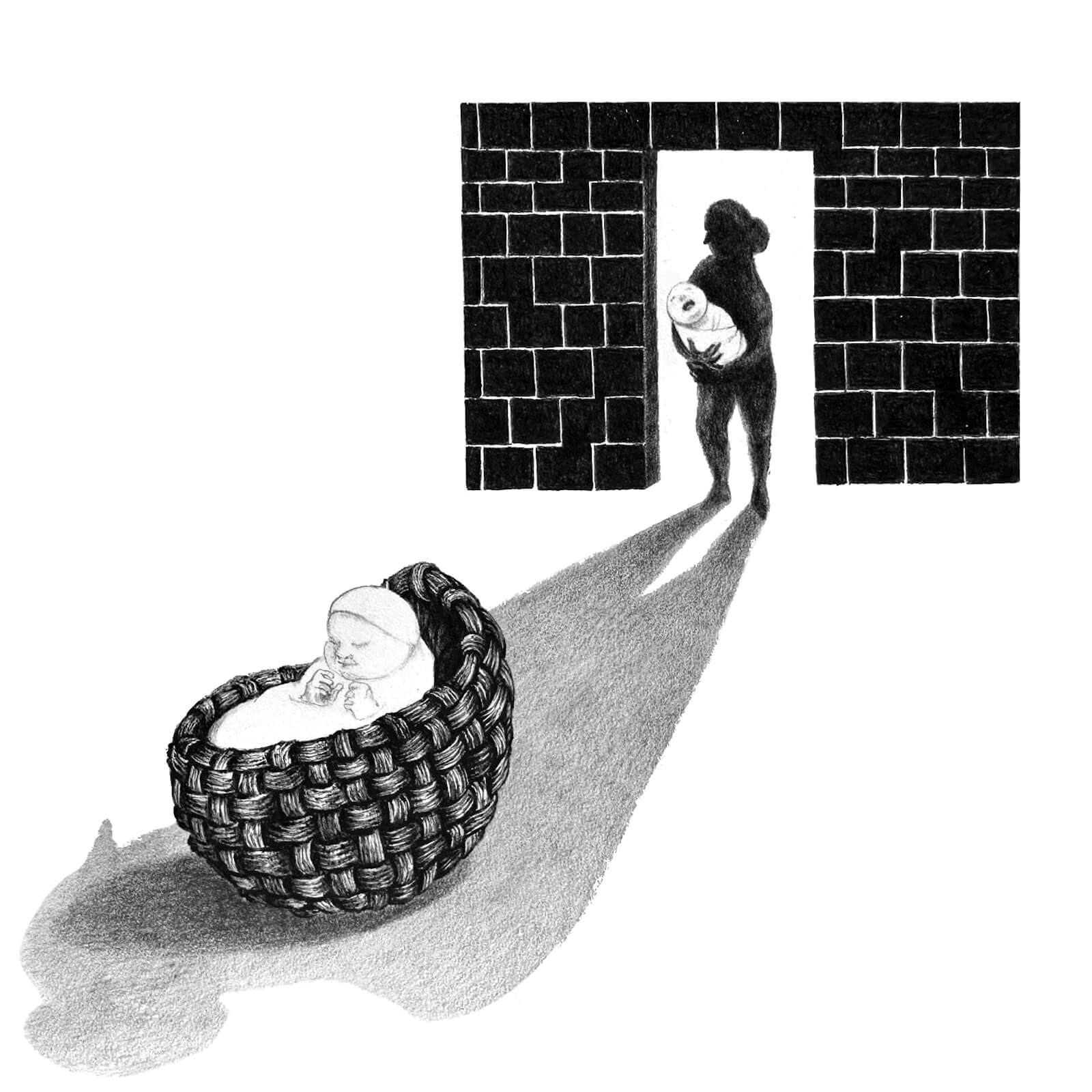
5. And even when the fairies faded out of truth and into myth, their shadows still dappled the walls of nurseries and crept the sheets on birthing beds. Could anyone really be sure they were gone? The fear remained as this: take the child to the altar; bow your head and pray for its absolution.
Outside, the woods: We’re surrounded by trunks with ragged scales of bark, shorn before the branches and cattail reeds.
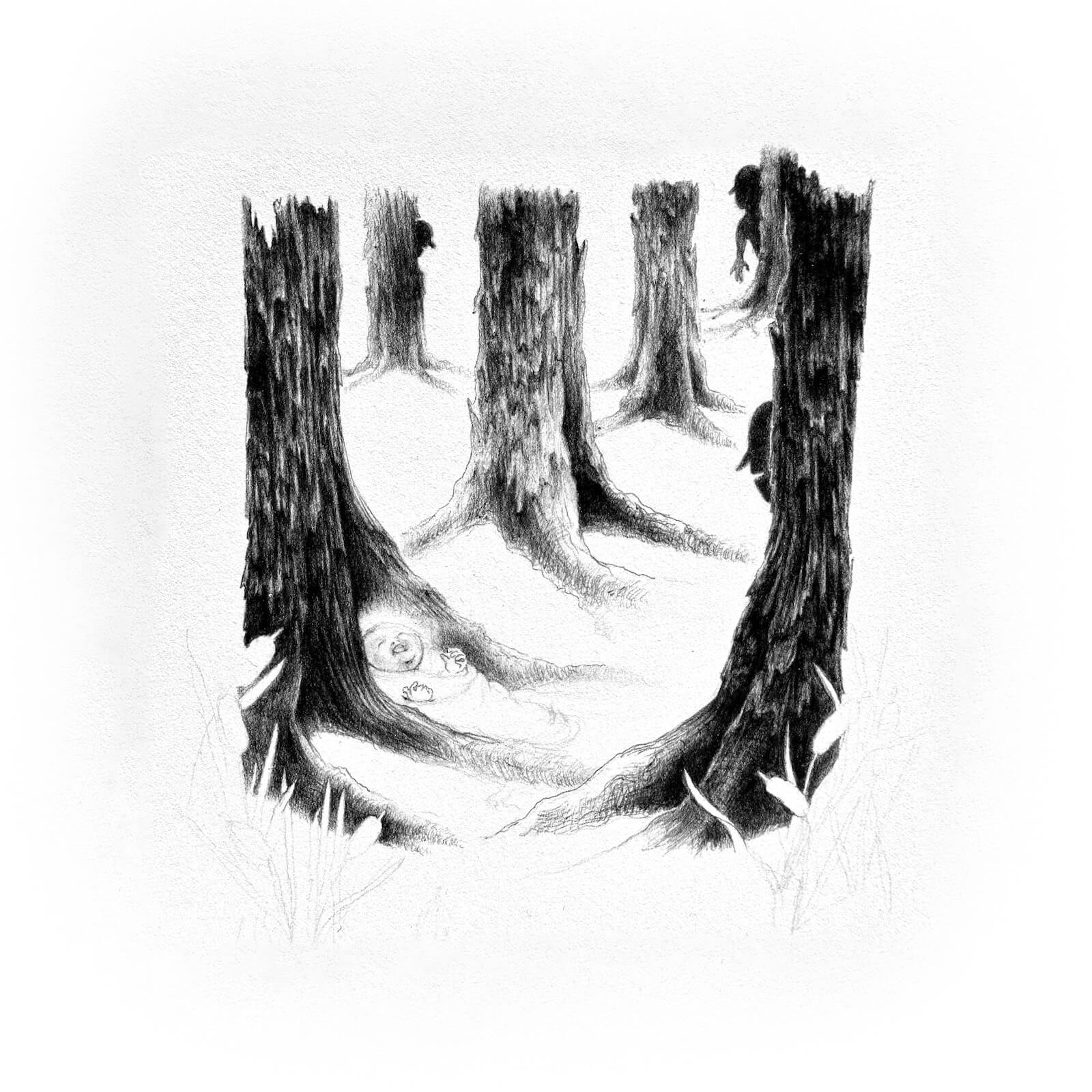
4. Soon the forests were humming with nervous chatter—the cackling of tricksters and mischievous spirits, the whispers of the “hidden people”—and a chilling suspicion rooted around sickly babies. Babies with fevers, babies slow to walk, babies who didn’t respond to noise or light…
The elders and midwives believed these were not anymore the children their parents had birthed; these were demonic changelings left by fairies in the stolen infant’s place. In such cases of nefarious exchange, families would be instructed to stop caring for the changeling, to beat it or set it alight, to leave it out in the woods as an offering. The babies would succumb to the wild, to the animals, to the wind and water.
Wandering deeper into the forest, more cattails sprout on the sloping, craggy bank of a bog. A nervous shadow figure kneels in the reeds pointing at their own neck and staring down into the rippling water. A face that could be their reflection bobs on the surface, with lips parted. Submerged in the bog: swaying water grasses.

3. Above ground, clans across Iron Age Northern Europe built their stone and sedge-thatched huts by the cold rainwater bogs. There, children born with deformities and those who limped were considered conduits to the gods—and as such, attuned to natural phenomena and responsible for their community’s survival. But when they failed to predict the rain fall or a good harvest, these young folk became scapegoats: the Kayhausen Boy walked with a limp, and at eight years old he was hogtied, stabbed, and sunk into a bog; the small, teenaged Yde Girl had a curved spine and was dropped into the water after being strangled with braided cloth from her own frock. There were others, children floating in wet eternity, their final admonishment preserved in the peat.
Tunneling through the earth: Under the thick peat and water reeds we encounter wet dirt and webbed roots and bones and shells and stones, meandering claw-dug burrows of fossorial critters, the skeletal remains of a shrew…

2. Up we go again through eons of mud and rock and sand.
Under everything buried and long forgotten, the air seeps dense and cold. In the belly of a cave, a nude figure sits building tripodal companions. All around, rows of jagged stalactites and stalagmites fade into the receding, hollow dark, dripping and spiraled and slick. The figure pauses holding a flat reflective disc, poised to place it atop the third and only unfinished tripod. Two completed metal companions point their shining discs toward the seated maker. Their forms are simple: three straight bronze legs adhered to a thin ring by two round rivets. Simple bodies, but they are aglow with longing. They are curious. The figure is glowing too. The source of the light is unclear…

1. The automatons are gone. Alone in the dark, the figure is an outline, a ghost, water droplets wearing away the rock. He is the ancient Greek god Hephaestus, disabled from birth and thrown from Mt. Olympus because of it. Because even among the gods there is stratification, and so this crumbling deity of sculptors and sculptures made his workshop beneath layers of slate and shale. In isolation under a mountain, Hephaestus forged tools and weaponry that empowered all the holy warriors in the pantheon.
On stone and clay, he is variously depicted as having club feet, backwards legs, or curled limbs. He drags his feet, uses a cane, or relies on his handcrafted tripodal automatons for support. These automatons are sleek metal proxies that move freely and visit the palaces of other gods while Hephaestus stays in the earth, dripping sweat and cleaving rock.
Click items 1-4 in the wiggling icon